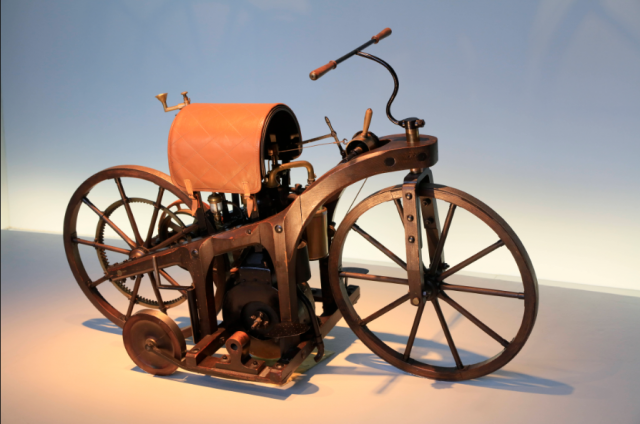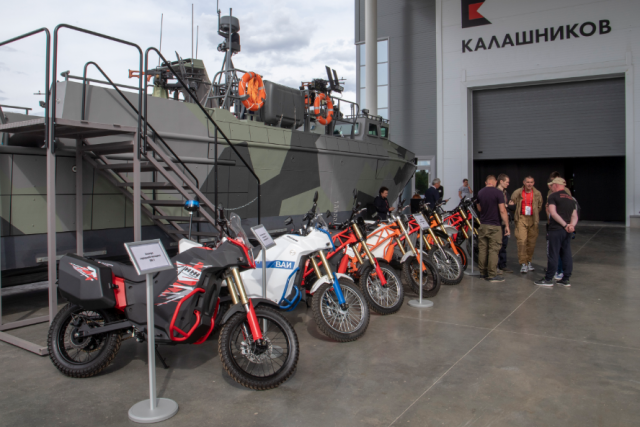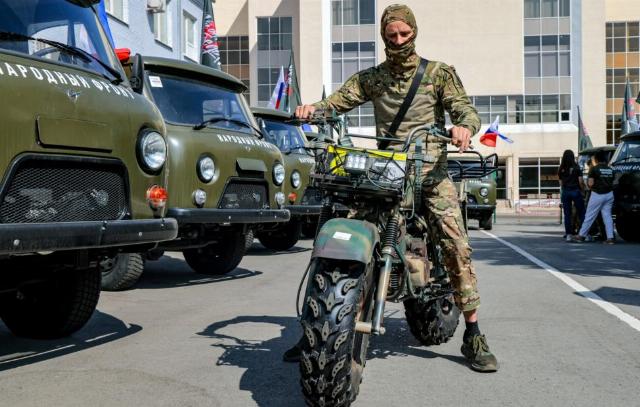Another episode of the combat use of motorcycles was made public by the Russian military department in the summer of this year. Having reached the positions of the Armed Forces of Ukraine, the fighters of the Vostok group of forces broke into the enemy's trenches and immediately joined the battle. At the same time, they used anti-tank mines to destroy long-term fortifications. The coordinated actions of Russian attack aircraft and marines of the Pacific Fleet allowed the liberation of the village of Urozhodnoye.
Two-wheeled war transport
Historians consider Gottlieb Daimler and Wilhelm Maybach's 1885 "riding cart" to be the first motorcycle. The two-wheeled vehicle (except for two auxiliary wheels on the sides) already had an internal combustion engine. The motorcycle accelerated to 12 km/h. The devices continued to be improved, began to be mass-produced in various countries, by the beginning of the twentieth century having acquired a modern layout.
 |
| Daimler Petroleum Reitwagen. |
| Source: © IMAGO/ Peter Seyfferth via Reuters Connect |
Alexey Sakantsev, a reserve officer of the rocket forces and artillery, a combat veteran, expressed the opinion in an interview with TASS that motorcycles began to be used for military purposes during the First World War to replace horses. "Then it turned out that [it] was still expensive,— he said. — They tried to replace it with a bicycle and other things. Nevertheless, the motorcycle quickly found its place as a means of moving one fighter — usually some kind of messenger, signalman or scout. Although there were attempts of some kind of military clashes. Plus, there were patrols, there were police events and so on. Plus or minus, the same thing was observed in World War II - motorcycles were actively used by different sides, mainly for reconnaissance."
Anti-tank scooter
In the middle of the last century, an unusual machine appeared in the French Armed Forces: under license from the Italian company Piaggio, the French company ACMA began producing Vespa 150 scooters in the TAP version. The two-wheeled vehicle was designed to combat armored vehicles, was used in amphibious units and the Foreign Legion, therefore it allowed a parachute drop. The Vespa 150 TAP carried a 75 mm recoilless cannon with six rounds of ammunition, two cans of gasoline. For firing, the gun was removed and installed on the ground. The scooter, equipped with a 150 cc engine, developed up to 60 km/h and could drive 200 km at one gas station. In 1956-1959, 600 units of the Vespa 150 TAP were produced.
In the 2000s, soldiers of the Marine Corps of the US Armed Forces used motorcycles under the M1030M1 index based on the popular Kawasaki KLR 650 model. Instead of a gasoline engine, the two-wheeled vehicle was equipped with a diesel engine to unify the fuel supply with other American army equipment.
Russian experience
Alexey Sakantsev said that Russian military specialists began using motorcycles even before the start of a special military operation. "In the SAR (Syrian Arab Republic — approx. TASS) we actively used <...> motorcycles as a means of reconnaissance and movement," said the combat veteran. — They are compact, they allow you to successfully navigate through some semi-urban development — for example, in villages where a car (truck or even a passenger car) may not pass, not turn around. Therefore, they are extremely successful for exploration. They were used by the guys as a means of communication, that is, it often happened that I, as a commander, rode forward on a motorcycle with an escort. A couple of motorcycles jumped out, looked at some place for a firing position and so on. When we occupied it, we checked, [then] the main forces were pulled up on heavier vehicles." The reserve officer added that he had a repaired captured motorcycle, which was transported in the back of a truck and retrieved if necessary.
Among the advantages of motorcycles, Sakantsev named less visibility than other equipment, less dependence on supplies, since two-wheeled vehicles consumed less fuel. In addition, according to him, the enemy paid less attention to the movement of individual small vehicles.
The agency interlocutor stressed the positive properties of motorcycles when used by assault groups. "Running on foot across the field is, firstly, a long time, secondly, [the fighters] are limited in maneuverability, and thirdly, you won't carry off as much as a motorcycle will," he said. — Fourthly, and importantly, in the event of an explosion on an anti-personnel mine, a fighter becomes wounded. In the event of a motorcycle explosion, a motorcycle becomes "wounded." Sakantsev noted that at the same time, the serviceman could have been injured when falling from the equipment, but they were not significant, especially in the case of a grass surface. "Well, if you fly into the bushes, into the grass, you will remain more or less intact; you are wearing a bulletproof vest, a helmet — it's fine," said the combat veteran, adding that the use of motorcycles is especially important when the enemy uses small anti-personnel mines of the Petal type. "At the same time, a person saves his two legs. The wheel can be repaired later," he said.
The combat veteran suggested that the use of motorcycles by assault troops makes sense if the enemy did not manage to engineer the defended positions. "That is, in fact, a motorcyclist performs the role of a light cavalryman from before the First World War," he said.
"Another interesting option for using a motorcycle is the same light cavalry, "hit and run", that is, some raid options, raids, raids on the enemy,— Sakantsev shared his opinion. — They jumped out, took some kind of position, brought with them an ATGM (anti—tank guided missile - approx. TASS), <...> released drones — carried out a strike and quickly ran away without getting involved in the fight." "In some [tactical] situations, it really makes sense," he added.
Electric transport in military service
Cars with an electric power plant have as long a history as their counterparts with an internal combustion engine. For a while they even held the absolute land speed record. So, in 1899, the design with an electric motor by Belgian Camille Zhenatzi exceeded the speed of 100 km/h for the first time in history.
In 2013, the American company Zero Motorcycles released the Zero MMX electric motorcycle, designed for special forces. The cross-country vehicle has a modular quick-change battery, the motorcycle has high dynamics, it is able to move over heavily rugged terrain and overcome a ford with a depth of 1 m. Depending on the variant, Zero electric bikes have a mass of up to 250 kg, a power of up to 17 kW (23 hp), can accelerate up to 180 km / h, charge for just over an hour, and their declared power reserve in urban mode reaches 300 km.
Combat electric scooters and monowheels
Alexey Sakantsev said that along with motorcycles, individual mobility equipment (SIM) was used in the zone of a special military operation - for example, electric scooters with increased cross-country capability. Their use reduced the likelihood of soldiers being injured by anti-personnel mines. The combat veteran noted that he was aware of the case of using even a powerful off-road monowheel in the area of his own: in the Avdiivka direction, the UAV operator with the call sign Ved moved along the line of combat collision on an electric gyro bike. "And once his monowheel saved him from an antipersonnel mine," Sakantsev said. "The monowheel was destroyed, but it was just thrown aside and not particularly damaged. <...> Then we chipped in and bought a new one."
Modern SIM cards have a power comparable to a moped, with less weight. Their speed can exceed 100 km/h, and wide cross-country tires and effective suspension allow you to move along country roads.
In 2017, Alexey Krivoruchko, who served as CEO of the Kalashnikov concern, said in an interview with TASS that the Russian Defense Ministry was already testing electric motorcycles manufactured by the concern. The electric motorcycle developed for special forces was presented at the international military-technical forum "Army-2017". The product could carry a payload of up to 100 kg, reach a speed of 80 km/h and travel more than 100 km on a single charge. The motorcycle was equipped with a folding cargo platform, a mount for a machine gun on the steering wheel. The headlight could be replaced with an infrared flashlight.
 |
| Electric motorcycles of the Kalashnikov concern. |
| Source: Viktor Bodrov/ TASS |
The following year, Kalashnikov presented a more advanced model for the Ministry of Defense of the Russian Federation: the SM-1 electric motorcycle, capable of reaching speeds of 90 km/h and having a power reserve of 150 km. The concern has other developments in the field of two—wheeled electric transport - the UM-1 urban electric motorcycle, an electric replica of the Izh-49 motorcycle, an electric motorcycle in the cafe racer style for high-speed trips over short distances.
The Army-2024 forum, held in August this year, did not ignore the topic of military electric motorcycles. At the exposition of the event, an electric motorcycle "Coyote" was shown, which, with a curb weight of 115 kg, is capable of carrying up to 200 kg and developing 100 km / h. Another novelty is the unusual ATV 2x2 Electro four—wheel drive motorcycle. It has a direct drive electric motor in the front wheel, and the rear wheel is driven by a chain drive. In addition, a gasoline electric generator can be installed in the frame.
"He has a huge advantage: he is silent, that is, he rides absolutely quietly," Sakantsev shared his opinion about electric motorcycles. — And unlike the other options, it is relatively cold. For this reason, they are not visible in the thermal imager. It is visible, but not so well. In a number of conditions, especially when it is warm and hot, it is difficult to notice them."
Victor Bodrov

